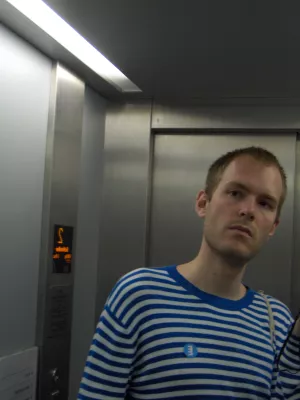
Jacob Korczynski
Doctoral student

separation penetrates : Emre Hüner, Jen Hutton, Steffani Jemison, Steve Kado, Anne Low, Josephine Pryde, Hassan Sharif
Author
Other contributions
- Emre Hüner
- Jen Hutton
- Steffani Jemison
- Steve Kado
- Anne Low
- Josephine Pryde
- Hassan Sharif
Summary, in English
Start together – then separate.
“One is inside
then outside what one has been inside
One feels empty
because there is nothing inside oneself
One tries to get inside oneself
that inside of the outside
that one was once inside
once one tries to get oneself inside what
one is outside:
to eat and to be eaten
to have the outside inside and to be
inside the outside”¹
While knots can be complicated to untangle they don’t always hold. Just a few years after publishing Knots (1970), his study of relationships through monologue and dialogue, R.D. Laing developed another book that traced exchanges between his two children. In the introduction to Conversations with Adam and Natasha (1977), Laing rejects the knot as relationship model in favour of the interweave – two or more subjects brought into proximity but not collapsed together or confused for the other.
In her introduction to the second collection of published interviews about her practice, Trinh T. Minh-ha describes the opening of the interval:
“Intervals allow a rupture with mere reflections and present a perception of space as breaks. They constitute interruptions and irruptions in a uniform series of surface; they designate a temporal hiatus, an intermission, a distance, a pause, a lapse, or gap between different states; and they are what comes up at the threshold of representation and communication – what often appears in the doorway…”²
As engaged by Emre Hüner, Jen Hutton, Steffani Jemison, Steve Kado, Anne Low, Josephine Pryde and Hassan Sharif, both interweave and interval act as caesurae – interruptions in an artwork, pauses that produce spaces where there can be a presence that is our own.
—Jacob Korczynski
“One is inside
then outside what one has been inside
One feels empty
because there is nothing inside oneself
One tries to get inside oneself
that inside of the outside
that one was once inside
once one tries to get oneself inside what
one is outside:
to eat and to be eaten
to have the outside inside and to be
inside the outside”¹
While knots can be complicated to untangle they don’t always hold. Just a few years after publishing Knots (1970), his study of relationships through monologue and dialogue, R.D. Laing developed another book that traced exchanges between his two children. In the introduction to Conversations with Adam and Natasha (1977), Laing rejects the knot as relationship model in favour of the interweave – two or more subjects brought into proximity but not collapsed together or confused for the other.
In her introduction to the second collection of published interviews about her practice, Trinh T. Minh-ha describes the opening of the interval:
“Intervals allow a rupture with mere reflections and present a perception of space as breaks. They constitute interruptions and irruptions in a uniform series of surface; they designate a temporal hiatus, an intermission, a distance, a pause, a lapse, or gap between different states; and they are what comes up at the threshold of representation and communication – what often appears in the doorway…”²
As engaged by Emre Hüner, Jen Hutton, Steffani Jemison, Steve Kado, Anne Low, Josephine Pryde and Hassan Sharif, both interweave and interval act as caesurae – interruptions in an artwork, pauses that produce spaces where there can be a presence that is our own.
—Jacob Korczynski
Department/s
- Malmö Art Academy
Publishing year
2017-12-01
Language
English
Document type
Exhibition
Publisher
Mercer Union
Topic
- Visual Arts
Status
Published